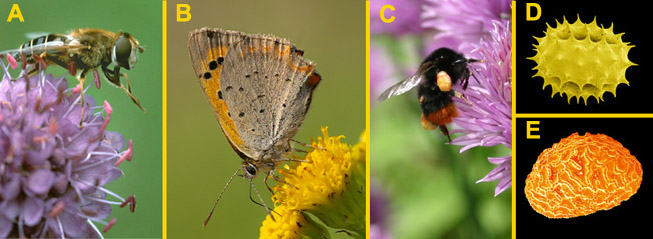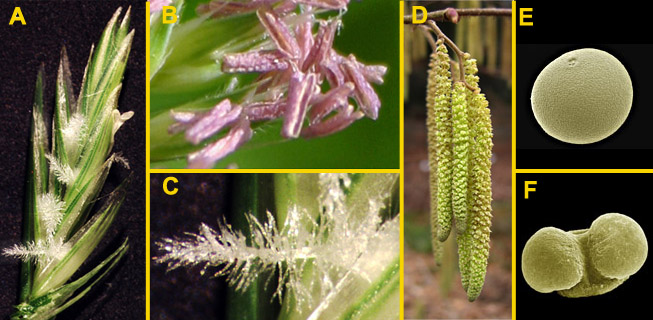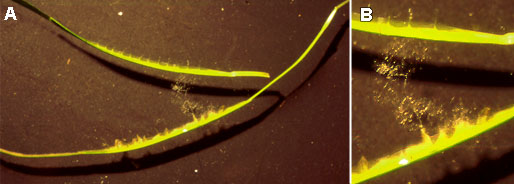Pollination |
||||||||||||||||
Since pollen itself is immobile, help is required in order to transport pollen from the loculi of the anthers to the recipient stigma in the pistil so that eventually fertilization can be achieved. This transfer is called pollination. There are in principle three ways to transfer pollen:
Disperal by animals: ZoophilyIn 80%of the plant families pollen is dispersed by animals, mostly by insects (in this case a process called entomophily from the Greek: insects-friendly), who collect pollen and sometimes also consume it, like bumblebees and bees, but also butterflies and hoverflies. In the tropics also birds, in particular colibries, and mammals like bats are involved in the dispersal of pollen. Plant which depend on animals for pollen transport have nearly always large and colorful flowers with a strong smell to attrack the pollinator. These plant species produce much honey and are often adapted to the visit of one particular type of insect. The pollen grains of such plants have often a coarse surface and they are often covered by a sticky oily fluid, the pollenkitt (more hereabout in "Pollen development").
Dispersal by the wind: AnemophilyBy dispersal through the air pollen is blown aways from the anthers and reaches the stigma of another plant of the same species by chance. These plants have often small, inconspicious flowers that are clustered in large groups, like in inflorescences of grasses (ears) and in catlins of many trees like Hazel. Characteristic for the anthers of many of those plants is that they stand out. Also the stigmata protrude outside the flowers and they are strongly branched in order to catch as much pollen as possible. Plants employing animophily produce large amounts of pollen grains that are commonly very small, without large extensions or any oily film on their surface. However, some species like Pine (Pinus sylvestris) appear to have large pollen grains, but those are relatively light thanks to their air bags, so that the wind can still carry them.
Pollen that is dispersed by the wind can reach the mucosa of nose and eyes. Some species can then cause allergy. However, not all types of airborne pollen are as strongly allergenic. Some species that produce a lot of wind-dispersed pollen grains, like the Ash (Fraxinus excelsior, "pollennieuws" video and illustrated descriptions, both in Dutch), do not cause hay fever. Pollination by water: HydrophilyEphydrophilous (i.e. water surface-pollinated) pollen grains are spherical or reniform and large, while hydrophilous (i.e. subaquatic-pollinated) pollen grains are filiform.
Webpages and photographs:Jan Derksen, Marijn Nijssen, Josef Ackerman and Elisabeth Pierson Drawings: Lidwien van der Horst Web development: Remco Aalbers |
||||||||||||||||


